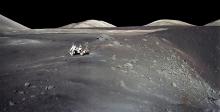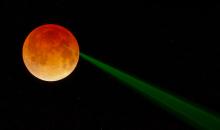Listen to today's episode of StarDate on the web the same day it airs in high-quality streaming audio without any extra ads or announcements. Choose a $8 one-month pass, or listen every day for a year for just $30.
You are here
Lunar Arrival
The final Apollo mission arrived at the Moon 50 years ago today, as commander Gene Cernan reported from the command module, America: Houston, this is America, you can breathe easier. America has arrived on station for the challenge ahead.
Apollo 17 was ambitious. Cernan and Jack Schmitt, a geologist, would spend three days on the Moon, in a valley known as Taurus-Littrow. It was picked because scientists thought it would give them a chance to sample two kinds of lunar terrain. One was the older material that forms the lunar highlands — the bright regions you see when you look at the Moon. The other was younger material produced by molten rock bubbling to the surface.
Cernan was a veteran of two space flights. Schmitt had never flown before. He was added to the mission when NASA cancelled his flight, Apollo 18. That made him the first and only trained scientist to walk on the Moon. Crewmate Ronald Evans, also a space rookie, remained in orbit. He operated cameras and other instruments that studied the Moon below.
The rocket firing that put them in lunar orbit went perfectly. And soon afterward, Schmitt reported something odd — the mission’s first bit of science: Hey, I just saw a flash on the lunar surface. MISSION CONTROL: Oh, yeah? SCHMITT: It was a bright little flash.
Scientists weren’t sure if the flash was caused by the impact of a small space rock or an eruption from the Moon itself.
Cernan and Schmitt landed the next day; more about that tomorrow.
Script by Damond Benningfield






